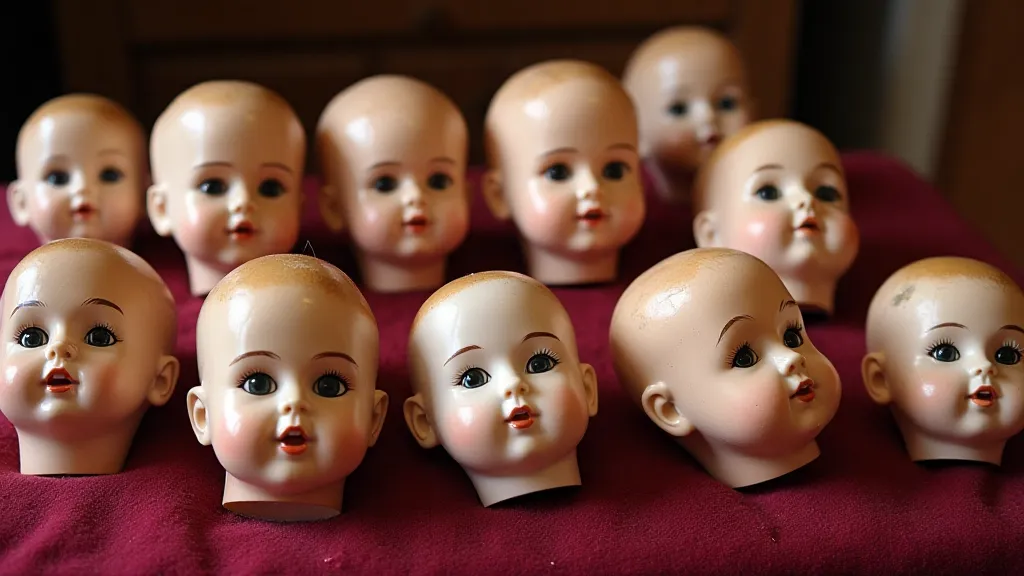The Silent Storytellers: Decoding the Markings on Antique Dolls
There's a quiet magic to holding an antique doll. More than just a toy, it’s a portal to another era, a tangible connection to a child who once cherished it, and a testament to the artistry of a bygone time. But beyond the charming face and delicate porcelain, lies a wealth of information often overlooked: the markings. These seemingly insignificant stamps, letters, and symbols are the silent storytellers, revealing the doll's maker, its origin, and a glimpse into the evolving landscape of doll manufacturing. Understanding these markings isn’t just a technical skill for collectors; it’s a journey into history, craftsmanship, and the very essence of a beloved pastime.
My own fascination with doll markings began with a simple, rather unassuming bisque head doll I found at a flea market years ago. It was chipped, its paint faded, but there was something captivating about its gaze. After countless hours of research, deciphering a tiny, almost illegible mark on its neck – “K.R.C.” – I discovered it was a Kämmer & Ritter doll from Thuringia, Germany, circa 1890. It wasn’t just a doll anymore; it was a link to a specific place, a specific maker, and a specific moment in time. That experience ignited a passion that continues to this day.
Early Markings: The Dawn of Doll Manufacturing
The history of doll markings is intertwined with the evolution of doll manufacturing itself. Before the mid-19th century, dolls were largely handmade, often by individual artisans or small workshops. Markings were rare, typically consisting of the maker’s name, often simply stamped or impressed into the doll's body. These early examples are highly prized by collectors, offering a tangible connection to a time when craftsmanship was paramount and mass production was a distant dream. Think of the early French Bébé dolls – often carrying just the maker's initials, providing a sense of intimacy and bespoke creation. The materials themselves also played a crucial role; understanding these materials requires more than just recognizing their appearance – it demands a deeper understanding of their origins and processing methods, as explored in Beyond Porcelain and Cloth: The Unsung Materials in Antique Doll Construction.
The rise of industrialization in the mid-19th century brought about significant changes in the doll-making world. Factories began to appear, and the need to identify the manufacturer became increasingly important. Doll heads, bodies, and limbs were often produced in different factories and then assembled, necessitating clear markings to track origin and quality. This period saw the proliferation of stamped marks, often containing the manufacturer’s name, city of origin, and sometimes even patent dates.

Deciphering the Symbols: Common Marks and Their Meanings
Understanding doll markings requires a degree of detective work. While there are some relatively straightforward marks – the names of well-known manufacturers like Jumeau, Bru, and Kestner – many others are more obscure or require careful interpretation. Here are a few common categories and examples:
- Manufacturer's Names: These are the most obvious markings and the easiest to identify. Examples include “Bru,” “Jumeau,” “Kestner,” “SFBJ” (Société Française de Bébé et Jouets), and “Rosenbourg.” Variations in font and style often indicate different production periods.
- City of Origin: Many German dolls, for example, bear markings indicating cities like Thuringia, Dresden, or Sonneberg. These markings provided valuable information about the geographical location of the factory.
- Patent Numbers: Patent numbers were frequently stamped on dolls to protect the manufacturer’s design. These numbers can be researched to determine the date of the patent and, by extension, the approximate date of the doll’s production.
- Composition Codes: As materials evolved, markings began to indicate the doll’s composition. "SF” denoted “Shebaite,” a common material used in early 20th-century dolls. "K” meant "composition," a mixture of materials designed to mimic porcelain.
- Logo Variations: Even within the same manufacturer, logos and markings changed over time due to design updates, mergers, or simply changes in production techniques. Careful observation and comparison with reference guides are essential.
The prevalence of German markings is significant, reflecting Germany’s dominance in the global doll manufacturing industry during the late 19th and early 20th centuries. However, marks from France, the United States, and other countries are also encountered, often displaying unique characteristics and design aesthetics. These dolls offer a fascinating window into the social and cultural forces shaping childhood, a subject richly explored in Echoes of Childhood: The Societal Tapestry Woven into Victorian Dolls.
The Shifting Landscape: From Germany to Beyond
The First World War and the subsequent economic instability dramatically impacted the doll manufacturing landscape. German factories were often forced to close or operate under significant constraints. This created an opportunity for other countries, particularly the United States and Japan, to enter the market. The markings on these dolls often reflected the changing national identities and evolving manufacturing processes.
After World War II, Japanese doll manufacturers became increasingly prominent, known for their mass production and affordability. While not always as highly prized by collectors, these dolls often bear unique markings reflecting Japanese design and craftsmanship. The stories behind these dolls, however, are not always idyllic. The pursuit of affordability often came at a cost, raising important questions about the human labor involved, a somber reality explored in Shadows of Industry: The Human Cost Behind Antique Doll Production.

The Collector’s Perspective: More Than Just Identification
For the serious doll collector, identifying markings isn’t just about cataloging and valuing a doll; it’s about uncovering a story. It’s about piecing together fragments of history and appreciating the ingenuity and artistry of the doll makers. It’s about understanding the social and economic forces that shaped the doll manufacturing industry.
Restoration considerations are also intrinsically linked to markings. Aggressive cleaning or refinishing can easily erase or damage delicate markings, significantly decreasing a doll’s value. A skilled restorer will always prioritize preserving the original markings, understanding their importance to the doll’s authenticity and historical significance. A doll with clear, legible markings is almost always more desirable than one with faded or altered markings.
Beyond the tangible value, antique dolls hold a profound sentimental worth, representing not just a childhood memory but a connection to a bygone era. The lasting appeal of these objects reflects a deeper longing for simpler times, a desire to recapture the innocence and wonder of youth. The very concept of value extends beyond monetary gain, encompassing the emotional resonance and cultural significance that these cherished objects possess – a nuanced perspective on value beautifully articulated in The Alchemy of Sentiment: How Antique Dolls Transmute Value Beyond Monetary Worth.

My own journey with antique dolls has been enriched by the challenge of deciphering these silent storytellers. Each marking is a clue, a piece of the puzzle. And while the process can be complex and time-consuming, the rewards – the connection to history, the appreciation for craftsmanship, and the satisfaction of uncovering a hidden story – are immeasurable. The small stamped letter on an antique doll head isn’t just a symbol; it’s a window to the past, patiently waiting to be understood.





